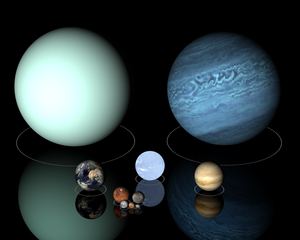Venus

Venus is the second planet from the Sun. It is a terrestrial planet and the third-smallest planet in our Solar System. Venus has a diameter of 12,103 kilometers. It orbits the Sun at 0.7 astronomical units away, or 108 million kilometers. It is very similar to Earth in many circumstances and has thus earned the nickname of Earth's "sister planet".
Mythology[edit]
The Mesopotamians identified the planet with their goddess Inanna (later Ishtar), their goddess of love, sex, fertility, war, justice, and political power. She is the daughter of the sky god Anu (who has Uranus named after his Greek equivalent). Her Roman equivalent is Venus, hence the planet's current western name. The asteroid 433 Eros is named after the goddess's son. In many east Asian mythology and current-day languages, the star was known as the "gold star" (金星), due to the planet's bright white-yellow atmosphere.
Properties[edit]
Venus is the hottest planet in the Solar System. This is because of its dense atmosphere. 96.5 of Venus's atmosphere is carbon dioxide, a greenhouse gas. These conditions make the temperature on Venus 466.85 °C on average; higher than the melting point of lead. Venus is sometimes referred to as the Morning Star. Venus is 10% less massive than Earth but nearly the same volume, making it less dense than Mercury on average.

